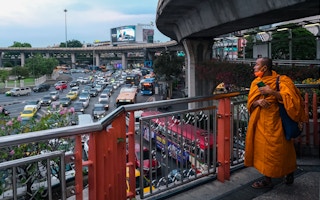Experts believe 15-minute cities, where most things are a short walk or bike ride away, could help tackle climate change and improve the quality of life, but conspiracy theorists see the idea as a bid to lock people up in their own neighbourhoods.
From Paris to Melbourne, Bogota to Bangkok, and Chicago to Nairobi, cities in five continents are implementing some 15-minute principles, aiming to become more accessible, interconnected, sustainable and healthy places to live.
Here’s what you need to know about 15-minute cities:
What is a 15-minute city?
Carlos Moreno, scientific director at the Université Panthéon-Sorbonne in Paris, pioneered the concept of the 15-minute city, aiming to create an urban landscape designed around people, not cars.
“It is a concept that seeks to change our lifestyles, our way of working too,” Moreno told Context.
The concept, he said, aims to reconcile three things:
- “Energy sobriety with less CO2; fewer fine particles in a move towards more ecological, more sustainable cities.”
- “Developing a local economy; more services and regenerating local colonies in all places in the city, to make a city much more liveable.”
- “Social interactions; interaction in public space, more culture and more generational medical care, more neighbourhoods with people,” he said.
The 15-minute city is a paradigm shift in urban planning, to ensure critical services like schools, grocery stores, workplaces and healthcare, but also parks and cultural spaces, are all within a 15-minute walk or cycle from home.
One-hundred-and-one cities, part of C40, a group of mayors collaborating to lessen the effects of climate change, have implemented some 15-minute city principles.
“
Before the pandemic, climate sceptic circles were already trying to push the idea that climate would be used as a pretext to restrict individual freedoms, but didn’t have a lot of traction with that idea. And that sort of changed with Covid when the idea of climate lockdown started trending.
Cécile Simmons, researcher, Institute for Strategic Dialogue
How are 15-minute cities implemented?
Turning the concept into reality goes from just adding green spaces to redesigning entire neighbourhoods.
Some examples include:
- Paris, where Mayor Anne Hidalgo has created 168 “school streets” with play areas and greenery in place of cars. Four neighbourhoods in the French capital have also been redesigned according to the principles of the 15-minute city.

















